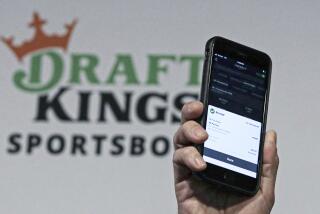NFL’s Free Agency System Tossed Out in Antitrust Suit : Football: Jury award to hit $1.63 million. League says it will appeal to keep limits on players’ team changes.
- Share via
MINNEAPOLIS — The National Football League’s limited free agency system was struck down by a federal jury Thursday in a landmark decision that could greatly alter the way the NFL does business.
After two days of deliberations, the eight-woman jury said that the current form of free agency, called Plan B, was in violation of federal antitrust laws. The jury also awarded damages totaling $543,000, which will be tripled to $1.63 million under federal antitrust laws.
“We do not regard this as anything less than a huge, huge, total victory,” said Jeffrey Kessler, an attorney for the players.
Frank Rothman, the lead attorney for the NFL, announced immediately that his side will appeal. Gene Upshaw, executive director of the NFL Players Assn., which funded the case for the athletes, said his side will seek an injunction to enforce the verdict.
The decision, if upheld, is the first step in allowing NFL players a less-restricted right of free agency, similar to that enjoyed by professional baseball and basketball players.
Free agents are allowed to move from club to club upon the expiration of their contracts if they meet certain criteria, such as length of time in the league. Baseball, which has the most liberal form of free agency, experienced an immediate and pronounced escalation in salaries. By comparison, football players are paid much less than baseball players. The average annual salary for a professional football player is $430,000. The average for a baseball player is $900,000 and for a basketball player it is more than $1 million.
During the 38-day trial, the NFL argued that unrestricted free agency would threaten the competitive balance of the league.
Eight players sued the NFL on grounds that Plan B is illegally restrictive. Under the NFL’s Plan B rules, each team grants free agency each year to the least desirable 35% of its players. The other 65%--the top 37 players in each club--are listed as restricted and unavailable for free agency.
The jury held that although all eight players were harmed by league rules, only four were entitled to financial damages. Dave Richards of the San Diego Chargers was awarded $240,000; Mark Collins of the New York Giants, $178,000; Lee Rouson, formerly of the Giants, $75,000, and Frank Minniefield of the Cleveland Browns, $50,000. All these amounts will be tripled.
The four awarded nothing were Freeman McNeil of the New York Jets, Tim McDonald of the Phoenix Cardinals, Dan Majkowski of the Green Bay Packers and Niko Noga, formerly of the Raiders and other clubs.
“Monetarily, the harm just wasn’t there,” juror Helen Shriner said afterward. “We were all in agreement that (NFL rules) substantially injure the players, but we had a difficult time agreeing on the exact amounts.”
The reason for the disparity is that in some cases, the evidence showed that second-string players moving to other teams on Plan B rules were awarded more lucrative contracts than first-string restricted players.
For example, Richards’ salary as a restricted player has been less than the salary paid to Mark May and others who joined the Chargers under Plan B to back up Richards at his position.
Doug Allen, an NFLPA executive, said that more than 1,000 other NFL players are either suing or will sue on the same grounds.
“Under treble damages, they’re entitled to $211 million,” Allen said.
Even so, Rothman doesn’t see the case as a total players’ victory.
“All they’ve ruled is that Plan B is too restrictive,” he said. “What it means is that we’ve got a job to do now on new rules.”
Technically, the league could simply put into effect a Plan C--reducing the number of restricted players from 37 to 35--and force the players to sue again.
Such a plan would, however, need the approval of Judge David S. Doty, who has been involved with this and similar suits since 1988.
“They know they can’t do a cosmetic change,” Upshaw said. “If they say they’ll go to Plan C, Plan B is gone and we will sue on Plan C. If they want to take that chance, we say fine. That is why we have the courts.”
Also unclear is the effect that Thursday’s action will have on the NFL’s college draft next April.
“Based on what the jury has just done, it doesn’t look good for the draft,” Upshaw said. “They’ve had their last draft.”
The NFL position is that it will continue with modifications.
Both sides predicted that negotiations toward a player-owner settlement will continue. The athletes have played the last five years without a collective bargaining agreement.
Football players and the team owners have been fighting over free agency since at least 1972, when Baltimore Colts tight end John Mackey brought a lawsuit against the league that led to the players winning the right to declare themselves unrestricted free agents.
The players surrendered that right in union contracts they agreed to in 1977 and 1982. In 1987, the players decided they wanted free agency after all. They went out on strike and began the litigation that led to the current lawsuit.
RELATED STORIES: C1
More to Read
Go beyond the scoreboard
Get the latest on L.A.'s teams in the daily Sports Report newsletter.
You may occasionally receive promotional content from the Los Angeles Times.










